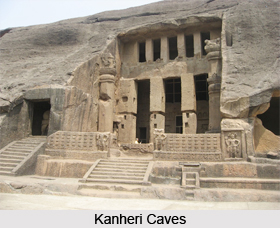 caves in Mumbai consist of almost 109 rock-cut Buddhist temples and shrines which can be traced back to 2000 years. The ancient monuments are situated inside the Sanjay Gandhi National Park, on the north of Borivali, Mumbai. The Buddhist monuments and shrines are carved out of a gigantic outcrop of basaltic rock. There are artworks found in Kanheri Caves depict the impact of Buddhism on Indian culture. Most of the caves are Buddhist monasteries that served as dwellings for meditation and gathering of knowledge. All the caves are adorned with intricately carved pillars, statuettes and sculptures. There are also stupas made of rock that were worshipped by the devotees. The exceptional figurine of Avalokiteshwarais is the most renowned sculpture. Furthermore, various inscriptions in Devanagari, Pallavi and Brahmi Script are also present in Kanheri caves.
caves in Mumbai consist of almost 109 rock-cut Buddhist temples and shrines which can be traced back to 2000 years. The ancient monuments are situated inside the Sanjay Gandhi National Park, on the north of Borivali, Mumbai. The Buddhist monuments and shrines are carved out of a gigantic outcrop of basaltic rock. There are artworks found in Kanheri Caves depict the impact of Buddhism on Indian culture. Most of the caves are Buddhist monasteries that served as dwellings for meditation and gathering of knowledge. All the caves are adorned with intricately carved pillars, statuettes and sculptures. There are also stupas made of rock that were worshipped by the devotees. The exceptional figurine of Avalokiteshwarais is the most renowned sculpture. Furthermore, various inscriptions in Devanagari, Pallavi and Brahmi Script are also present in Kanheri caves.
The caves are located in the interiors of the forest in the Sanjay Gandhi National Park, which is one of the key reasons for the preservation of the ancient artworks, despite being surrounded by the busy Mumbai city. Some of the caves are placed almost to 460 m above the sea level. A stunning view of the surrounding forest and also of the city can be seen from these caves.
History of Kanheri Caves
In the ancient times, the forest provided a route to the ports of Kalyan and Sopara. The route was used by Buddhist traders to reach the ports. As the journey was long, the Buddhist traders took shelter in the Kanheri cliffs, in the middle of the forest at nightfall. It was mainly due to this reason that the Buddhist monks created cells cut in rocks on the hillside during the 1st century BC. Later a pillared hallway and a stupa were also created. The cells, made in the Hinayana tradition, served as a haven for travellers of that time.
Moreover, reservoirs and cisterns are also carved on the rock for the purpose of storing water.
Eventually, these rock cut shelters were used more frequently and the caves were created in a sophisticated and improved way. The walls, ceilings and shrines in the caves were decorated with various images of Buddha as well as Bodhisattvas. During the 3rd century AD, Kanheri caves became very significant and prominent settlement of Buddhists. Most of the stunning and renowned artworks of the caves were created in the 5th - 6th century. These monuments and sculptures were intricate, sophisticated and larger than the previous artworks. Tibetan Buddhist teacher Atisha came to Kanheri caves and practiced meditation under the guidance of Rahulagupta.
Details of Kanheri caves
There are 109 caves in Kanheri that are cut and carved in basalt. All the caves contain cells or Viharas, used mainly as dwellings for the monks, and large halls or Chaityas used for worship. Cave 3 contains the largest chaitya and was crafted during the 2nd - 6th century AD, in the Hinayana tradition. There are 2 massive figurines of Lord Buddha, almost 7 m in height, on either side of the entrance. The chief hallway is also adequately large, 28 m in length and 13 m in width. The cave is embellished with 34 pillars and a stupa, 5 m in height. The pillars contain statues of elephants in a kneeling posture. Cave 11 is mainly an assembly hall that contains a figure of Lord Buddha in the middle of the shrine. There are also cells in the cave. There is a beautiful painting of Buddha on the ceiling of Cave 34. Cave 41 has a sculpture of Avalokitesvara, a Bodhisattva, and embodying 11 heads. Cave 67 has a verandah that is decorated with a sculpture of Avalokitesvara and 2 other female figures. The Mandala in Cave 90 was created in 6th century AD and is still well preserved.
Inscriptions of Kanheri Caves
Kanheri Caves contain several inscriptions, many of which have still not been deciphered. There are inscriptions that are in Brahmi script, that were created during the era of emperor Ashoka and his efforts to promote Buddhism. Many inscriptions on copper plates have also been gathered. It is evident from these inscriptions that Traikutas dynasty was highly influential during 533 AD. Around 18 copper plates were found in the caves. There are also inscriptions in Pahlavi found in Cave 90. More Inscriptions are found in Caves 21, 98 and 101 which refer to Krishna-saila, Kanha Shele and Krishnagiri respectively.




